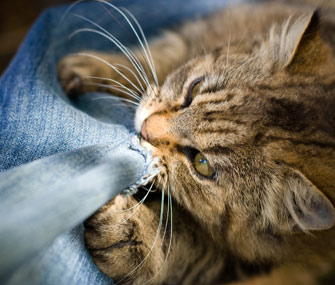Why Kittens Chew On Things — And How to Help Prevent It
Published on January 20, 2015
Skip To

Why Kittens Chew
Like babies and puppies, kittens tend to put objects in their mouths as a means of exploring and playing. They may chew because they are teething or just because it’s fun. Some kittens chew out of boredom. Of course, they chew many innocuous items, but they can also chew items we don’t want them to — most often electrical cords, houseplants, leather objects, clothing or shoes.Dangerous Items to Keep Away From Your Kitten
1. Electrical cords. Electrical cords are one of the more dangerous things your kitten can chew. And even though it’s not as dangerous, a chewed-through phone cord is pretty annoying. Cords look enticingly like strings and even make satisfying noises when batted about. Your first line of defense is to cover the cords. You can buy presplit hollow tubing or make some yourself to put over cords. In places where cords cannot be covered, make the area around them unappealing by covering it with two-sided tape or aluminum foil, both of which are unpleasant for cats to stand on. You can also buy motion-detecting devices made just for cats. These devices emit a harmless but annoying spray of water or compressed air and a high-pitch alarm. As for the cords, spray them with a bitter-tasting cat-deterring spray available from your veterinarian or pet supply store. Since cats are pretty particular about taste, such sprays tend to be effective.2. Houseplants. Houseplants are a natural enticement for many cats and kittens. But they, too, can be harmful. Some, like cacti, are dangerous mainly because they are pointy. Others, like amaryllis, c
3. Fabric, leather or rubber. When fabric, leather or rubber chewing occurs in kittens between the ages of 3 and 6 months, it’s often associated with teething. As new teeth come in, they make the gums uncomfortable. Chewing helps relieve that discomfort. Again, the best defense is putting chewable items out of reach and spraying those you can’t move or hide with bad-tasting spray. But you must also provide something else for your kitten to chew. Look for kitten-safe chewable soft toys (beware of small parts that can be chewed off and swallowed). Another option for some cats is a baby carrot. Even lettuce can provide cool, crunchy relief. Freeze wet cat food or special treats into cubes that can be doled out for the cat to chew and lick. Some cats aren’t crazy about cold food, but they will often make the exception if it’s tasty enough — or if they have a strong enough urge to chew.
How Play Can Help
Kittens may also chew out of boredom. Be sure to give your kitten plenty of interactive playtime, and when you can’t be with him, bring out a couple of interactive cat toys that release tiny food treats when he manipulates them. Make sure your kitten gets lots of active play and exercise.One thing to keep in mind: Some older kittens may suckle on certain fabrics, particularly wool. This may be a result of a combination of early weaning and genetics, and it may even manifest itself as an obsessive-compulsive behavior. Talk to your veterinarian if your kitten ingests odd items like wool or plastic grocery bags.
More From Vetstreet:





